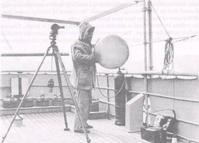


Memories of the Bureau of Meteorology
Preface
Memories of the Bureau of Meteorology 1929–1946 by Allan Cornish
Foreword
Chapter 1: My Early Days in the Bureau
Chapter 2: Some New Vistas
Chapter 3: The RAAF Measures Upper Air Temperatures
Chapter 4: The Bureau Begins to Grow
Chapter 5: My Voyage in Discovery II
Chapter 6: The Birth of the Instrument Section
Chapter 7: Darwin Days
Chapter 8: I Leave the Bureau
History of Major Meteorological Installation in Australia from 1945 to 1981 by Reg Stout
Four Years in the RAAF Meteorological Service by Keith Swan
The Bureau of Meteorology in Papua New Guinea in the 1950s by Col Glendinning
Index
Search
Help
Contact us

Chapter 5: My Voyage in Discovery II (continued)
As we proceeded eastward we mapped the coastline and sounded the ocean floor. We were the first to map the frequently fog-bound Balleny Islands, and spent three weeks doing this.There was little opportunity to make more than surface observations in meteorology. We had a theodolite fitted with gimbals but were unable to render it operational. Number one and I made some pilot balloon observations using two sextants. I suppose this was the only time such a method had been attempted. We did not achieve much success with our innovation.

Comprehensive surface meteorological observations were made as part of the normal ship's routine.
I was recruited to assist in operating the echo-sounders. I did a four hour watch on the echo-sounders twice a day. There were two echo-sounders. One measured depths from 5 to 15 fathoms (9 to 27 metres). The other, a large Admiralty instrument, was for oceanic depths to 5,000 metres. A large compressed-air driven hammer was mounted on the keel and controlled from the bridge deck. The hammer could be set to beat the keel at fixed intervals (say 2.5 second) and the time taken to get the return signal determined the depth. The device was somewhat primitive with response times manually recorded. The shallow water echo-sounder had a recording device. But with both echo-sounders there was a considerable amount of labour in working up the results. It was pretty tedious.
Each night between 8pm and midnight local time, the darkest hours of the 24, the ship would heave to and Number one would take over the bridge. A buoy would be thrown overboard and a searchlight trained on it. It was Number one's job to direct the head of the ship and use the engine so that Discovery II remained stationary. If there was some wind it was easy to hold the ship's position by turning into wind and adjusting engine speed. But if there was no wind you had a problem. Number one gave directions to the engine room by phone because the use of the engine room telegraph was too difficult. When Discovery II was holding position soundings would commence.
Organisations in Australian Science at Work - Frosterley Club
People in Bright Sparcs - Cornish, Allan William
 |
Bureau of Meteorology |  |
© Online Edition Australian Science and Technology Heritage Centre and Bureau of Meteorology 2001
Published by Australian Science and Technology Heritage Centre, using the Web Academic Resource Publisher
http://www.austehc.unimelb.edu.au/fam/0521.html